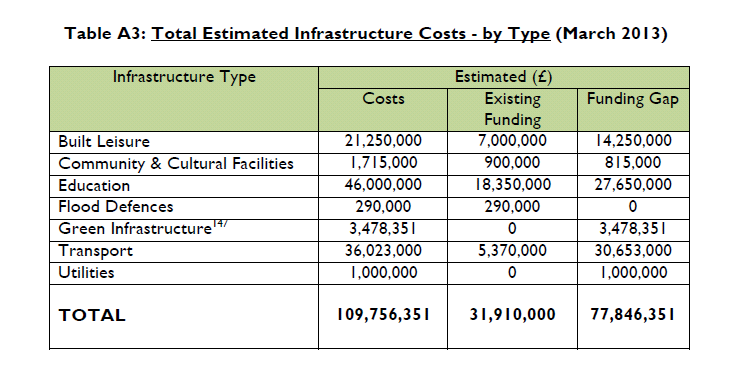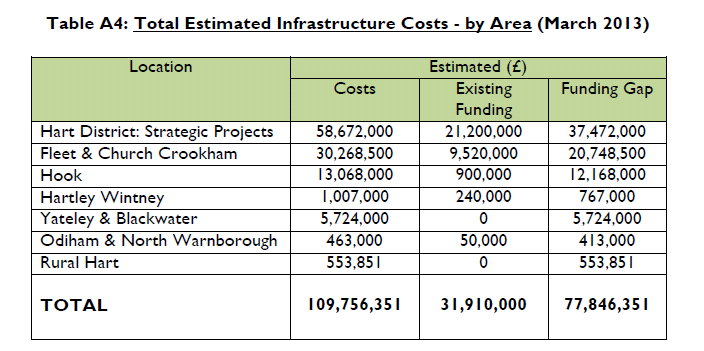Much is being made of the supposed infrastructure benefits of a new town in Hart District. We believe these benefits are a mirage and have written elsewhere about the astronomical £300m costs and the pitiful expected developer contributions. This post is about the massive infrastructure funding deficit facing our existing communities and how developer contributions won’t make a bit of difference to this and how a new town will make things worse.
Back in October 2014 Hart Council produced an infrastructure delivery schedule that set out the current deficit, split by type and area. This shows a deficit of £78m not including healthcare facilities. The breakdown is shown by type and area in the images below:

Hart District Estimated Infrastructure costs by type March 2013.

Hart District Estimated Infrastructure costs by area March 2013
Key quotes from the document include:
“It is therefore reasonable to conclude that it is unlikely that there will be sufficient future funds, from both capital programmes and developer contributions, within the plan period, to deliver all of the projects listed in the HCC Transport Statement”
“Although developer contributions will continue to play an important role in helping to bridge the funding gap, it is also clear that the funds raised through developer contributions will only contribute a modest proportion of the total identified funding gap”
“Developer contributions are, however, by no means the only source of funding for infrastructure providers. Local Authorities, for example, could fund the costs of meeting future unmet community infrastructure needs, in addition to developer contributions, through a variety of means including Infrastructure Provider Capital Programmes, Council Tax, Prudential Borrowing, New Homes Bonus, Grants (Government and private), Capital Receipts, Council Reserves and Local Economic Partnership (LEP) funding”
“The South West Main Line (SWML) outer trains, which serve Hart, has significant forecasted future peak crowding, with a capacity shortfall of over 6,100 passengers in the high-peak hour, even if every main line train is at maximum length”
As can be seen, Fleet, Church Crookham and Hook have the largest deficits and there is no way that developer contributions are going to make a dent in these, let alone cover the extra infrastructure costs of a new town. Nobody has yet explained how these deficits will be fixed by building a new town. On the contrary, a new town is likely to starve these areas of much needed investment.
If you would like to make your voice heard, we urge you to respond to the Hart District Council consultation about the Local Plan and ask them to think again. We have created a dedicated consultation page and two guides to responding to the consultation that are available on the downloads below. The comments are designed to be cut and pasted into the boxes provided. It will be very powerful if you could edit the comments into your own words. Please do find time to respond to the consultation and play your part in saving our countryside.
Full version:

2 Minute version:

Pingback: Fleet Town Council seeks to mislead the public | We Heart Hart
Pingback: Impact of a new town on Fleet and Church Crookham | We Heart Hart
I was once told by a senior auditor of an oil company to never trust an accountant who doesn’t ‘right align’ their figures as they are trying to hide something.
And my personal favourite: ‘All other major highway links entering or existing Hart District are predicted to experience only a minor increase in traffic flow as a result of the Local Plan development proposals or operate well within capacity.’
That is a joke, surely
It’s an official Hart DC document, David. It’s not a joke…
🙂
Also: ‘The South West Main Line (SWML) outer trains, which serve Hart,has significant forecasted future peak crowding, with a capacity shortfall of over 6,100 passengers in the high-peak hour, even if every main line train is at maximum length’.
SO much for “under-utilised station”
Two interesting little nuggets jump out from this document:
“Although developer contributions will continue to play an important role in helping to bridge the funding gap, it is also clear that the funds raised through developer contributions will only contribute a modest proportion of the total identified funding gap”. The footnote for this states: ‘Developer contributions are, however, by no means the only source of funding for infrastructure providers. Local Authorities, for example, could fund the costs of meeting future unmet community infrastructure needs, in addition to developer contributions, through a variety of means including Infrastructure Provider Capital Programmes, Council Tax, Prudential Borrowing, New Homes Bonus, Grants (Government and private), Capital Receipts, Council Reserves and Local Economic Partnership (LEP) funding’.
That’s right, folks. Hart could pump up your council tax to meet the shortfall.
So, the whole idea of a new town fixing the infrastructure is a complete myth?
Through developer contributions alone: yes. Apparently.
It also begs the question: If local authorities can meet funding shortfalls from development by other means, why haven’t Hart done this already for the shortfall they have at the moment?